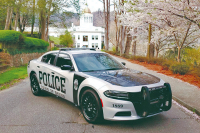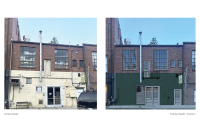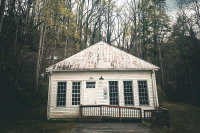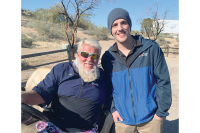From the North Country to the back country
 The beauty of bluegrass lies in its transparency.
The beauty of bluegrass lies in its transparency.
Whether you’re having a good or bad day, those emotions will filter through your voice and fingertips. You can’t hide behind the music — you are vulnerable to the listener, to yourself, and to the cosmos above. It’s a rare and beautiful thing to come across such honesty, pure intent and genuine face-to-face interaction that the music conjures in a modern, fast-paced world.
For renowned bluegrass group The Gibson Brothers, their journey began on a small dairy farm in the rural landscape of Ellenburg, New York. Tapping into the wellspring of storytelling and string music that runs deep in the ancestry of North Country folks (who immigrated to the area from the British Isles via the St. Lawrence Seaway), the siblings strapped on their instruments and hit the road.
And in their almost 30 years together, Eric and Leigh Gibson have steadily risen into upper echelon of the genre, ultimately receiving a slew of awards from the International Bluegrass Music Association, including “Emerging Artist of the Year” (1998), “Song of the Year” (2010, 2013), “Vocal Group of the Year” (2011, 2013), “Album of the Year” (2011), “Songwriter of the Year” (2013), and “Entertainer of the Year” (2012, 2013).
Bluegrass is the soundtrack of our country and its people — past, present, and future. With one foot in tradition and the other in evolution, it is as timeless as it is vital to the perpetuation of humanity.
Garret K. Woodward: Myself being from rural Upstate New York, I discovered bluegrass through The Gibson Brothers. But, how did you discover bluegrass?
Related Items
Eric Gibson (banjoist/singer): My father and mother liked listening to it on the radio. There was this local station that played it on Saturday nights, and we’d occasionally see it on “Hee Haw” and “Austin City Limits.” Dad always wanted to play, but he didn’t because he’d been working like a man since he was 9 years old. But, there were instruments around our house, pieces he would pick up at an auction or whatever. And when I was 11, Leigh and I started taking lessons at Dick’s Country Store & Music Oasis [in Churubusco, New York] from Eric O’Hara.
GKW: Eric O’Hara? I know him. Wasn’t he in the band Zip City?
EG: Yes. Eric got us hooked on Flatt & Scruggs, Ricky Skaggs, John Hartford, Tony Rice, and Seldom Scene. We started doing some local festivals, like in Jericho, New York, as you know. Then we started going to fiddler contests, and there are lots of fiddlers over the border in Quebec, and they took us in because we were close enough. It all kind of grew from there.
GKW: People always ask about how I know so much about bluegrass being from Upstate New York, and I say because it’s not just a Southern thing, it’s a rural thing.
EG: I think you’re right. Bluegrass is never far from the mountains, and nor were we up there in the foothills of the Adirondacks. That, and people are just people everywhere we go, so why wouldn’t we like bluegrass? It’s great music.
GKW: With bluegrass, a lot of it derives from the British Isles, with many of those immigrants coming into America through the St. Lawrence Seaway, settling in Ontario or Quebec, and ultimately pushing down into Upstate New York.
EG: And, that’s our story. Some of our songs talk about that exact story, of our ancestors doing just that. And a couple of them ended up joining the Union Army, which, I’m pretty sure, is how our family ended up with the farmland we grew up on.
GKW: My ancestors came from Ireland, down the Seaway, through Alexandria Bay and into Clinton County. Storytelling and music has been part of that culture forever — it’s in our blood.
EG: Yeah, exactly. I actually have the truck of my ancestors that came on the boat from Scotland. It’s right under my bed.
GKW: What about the North Country landscape and how it affects the music?
EG: First of all, it’s just so beautiful up there. I think a lot of the country, and the world, isn’t aware of just how beautiful it is. And it can get very isolated up there, where you kind of get a chip on your shoulder. I used to hear people say things like, “Well, ‘so and so’ is a good baseball player or a good musician, but he can’t be that good because he’s from here.” Why does it matter where you’re from? You can be from small towns and achieve your dreams. Find what you love and give it everything you’ve got. It’s not always easy, but when you love something enough, and truly know you’re supposed to be doing it, it never feels like work. I also never take any of this for granted. It could be gone at any moment, so we just keep pushing ahead.
GKW: What is it about bluegrass that sets it apart from other forms of music?
EG: There’s something so beautiful about bluegrass when it’s done well, those close harmonies and high notes — that high lonesome sound. And it’s hard to make it sound right.
GKW: Like making it look easy shows the most skill, right?
EG: Yeah. With bluegrass you can’t hide behind anything, no effects or anything. And, so many of the people in the audience are great players, too.
GKW: And with the modern era, it seems more and more folks are gravitating towards bluegrass, where it represents something real and authentic.
EG: I hope you’re right. Every so often, I get scared, thinking, “Is this music going to survive?” or “Are enough people coming along to keep it going?” And I think there will be, and already are, in many aspects. Where we are on the spectrum, some folks say we’re not bluegrass, but, “We like yah,” and then other places they go, “Well, thank god you play real bluegrass.” [Laughs].
GKW: And you still keep pushing down the road.
EG: We’ve met so many incredible people. And I think what if I had done something different? What if there was no banjo to pick up? What would Leigh and I have done? I guess it was just meant to be. You know, the longer I’m in this, the less scared I am just to be myself, where it’s going out there, when you can just breathe, and be you. Not everybody will love you, but the ones that do, they do, and that’s good enough for me.
Want to go?
The Cherokee Bluegrass Festival will run from June 2-4 at the Happy Holiday RV Village & Campground, located at 1553 Wolfetown Road in Cherokee.
Among the numerous acts to hit the stage, headliners include The Gibson Brothers (June 2), Larry Sparks & The Lonesome Ramblers (June 4), Rhonda Vincent & The Rage (June 3), Gene Watson (June 3), Balsam Range (June 4), The Grascals (June 4), and more.
In advance, one-passes are $40, with three-day passes $90. For more information on tickets or the festival schedule, click on www.adamsbluegrass.com or call 706.864.7203.









